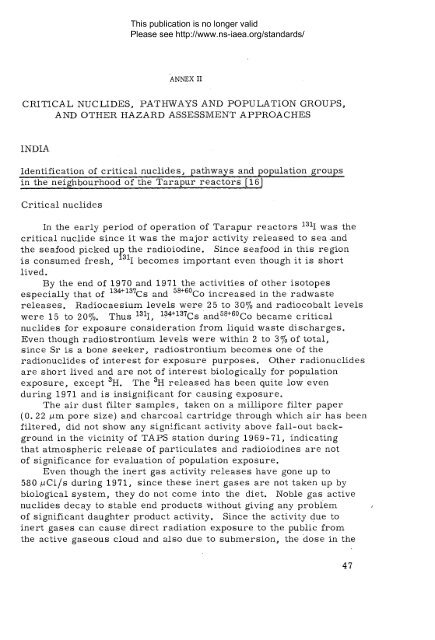Safety_Series_041_1975 - gnssn - International Atomic Energy ...
Safety_Series_041_1975 - gnssn - International Atomic Energy ...
Safety_Series_041_1975 - gnssn - International Atomic Energy ...
You also want an ePaper? Increase the reach of your titles
YUMPU automatically turns print PDFs into web optimized ePapers that Google loves.
This publication is no longer valid<br />
Please see http://www.ns-iaea.org/standards/<br />
A N N E X II<br />
CRITICAL NUCLIDES, PATHWAYS AND POPULATION GROUPS,<br />
AND OTHER HAZARD ASSESSMENT APPROACHES<br />
INDIA<br />
Identification of critical nuclides, pathways and population groups<br />
in the neighbourhood of the Tarapur reactors [16]<br />
Critical nuclides<br />
In the early period of operation of Tarapur reactors 131I was the<br />
critical nuclide since it was the m ajor activity released to sea .and<br />
the seafood picked up the radioiodine. Since seafood in this region<br />
is consumed fresh, I becom es important even though it is short<br />
lived.<br />
By the end of 1970 and 1971 the activities of other isotopes<br />
especially that of 134+137Cs and 58+60Co increased in the radwaste<br />
releases. Radiocaesium levels were 25 to 30% and radiocobalt levels<br />
were 15 to 20%. Thus 131I, 134+137Cs and58+60Co became critical<br />
nuclides for exposure consideration from liquid waste discharges.<br />
Even though radiostrontium levels were within 2 to 3% of total,<br />
since Sr is a bone seeker, radiostrontium becom es one of the<br />
radionuclides of interest for exposure purposes. Other radionuclides<br />
are short lived and are not of interest biologically for population<br />
exposure, except 3H. The 3H released has been quite low even<br />
during 1971 and is insignificant for causing exposure.<br />
The air dust filter sam ples, taken on a m illipore filter paper<br />
( 0 . 22 /um pore size) and charcoal cartridge through which air has been<br />
filtered, did not show any significant activity above fall-out background<br />
in the vicinity of TAPS station during 1969-71, indicating<br />
that atmospheric release of particulates and radioiodines are not<br />
of significance for evaluation of population exposure.<br />
Even though the inert gas activity releases have gone up to<br />
580 mCi /s during 1971, since these inert gases are not taken up by<br />
biological system , they do not come into the diet. Noble gas active<br />
nuclides decay to stable end products without giving any problem<br />
of significant daughter product activity. Since the activity due to<br />
inert gases can cause direct radiation exposure to the public from<br />
the active gaseous cloud and also due to submersion, the dose in the<br />
47

















